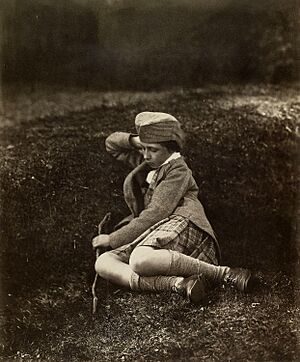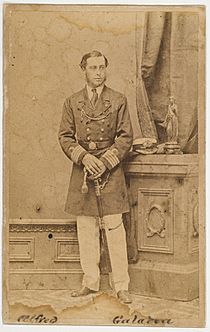Alfred, Duke of Saxe-Coburg and Gotha facts for kids
Quick facts for kids Alfred |
|||||
|---|---|---|---|---|---|
| Duke of Edinburgh | |||||
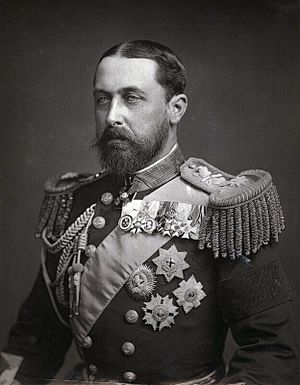
Prince Alfred in 1881
|
|||||
| Duke of Saxe-Coburg and Gotha | |||||
| Reign | 22 August 1893 – 30 July 1900 | ||||
| Predecessor | Ernest II | ||||
| Successor | Charles Edward | ||||
| Born | 6 August 1844 Windsor Castle, Windsor, Berkshire, England |
||||
| Died | 30 July 1900 (aged 55) Schloss Rosenau, Coburg, Duchy of Saxe-Coburg and Gotha, German Empire |
||||
| Burial | 4 August 1900 Friedhof am Glockenberg, Coburg |
||||
| Spouse |
Maria Alexandrovna of Russia
(m. 1874) |
||||
| Issue |
|
||||
|
|||||
| House | Saxe-Coburg and Gotha | ||||
| Father | Prince Albert of Saxe-Coburg and Gotha | ||||
| Mother | Queen Victoria of the United Kingdom | ||||
| Military career | |||||
| Allegiance | |||||
| Service/ |
|||||
| Rank | Admiral of the Fleet | ||||
| Commands held |
|
||||
Alfred (Alfred Ernest Albert; 6 August 1844 – 30 July 1900) was a British prince. He later became the ruler of the Duchy of Saxe-Coburg and Gotha from 1893 to 1900. He was the second son of Queen Victoria and Prince Albert. From 1866, he was known as the Duke of Edinburgh. He became the Duke of Saxe-Coburg and Gotha after his uncle, Ernest II, passed away.
Contents
Early Life of Prince Alfred
Prince Alfred was born on 6 August 1844 at Windsor Castle. His parents were Queen Victoria and Prince Albert. He was the second son and fourth child of the royal couple. People often called him "Affie." He was second in line to the British throne. His older brother, the Prince of Wales, was first.
Alfred was baptized on 6 September 1844. This happened in the Private Chapel at Windsor Castle. He remained second in line to the throne until 1864. Then, his older brother Edward had his first child, Prince Albert Victor. As Edward and his wife had more children, Alfred moved further down the order of succession.
In 1856, when Alfred was 12, he decided to join the Royal Navy. This was his own wish. He passed a special test in July 1858. He became a naval cadet on the ship HMS Euryalus at 14.
In July 1860, he visited the Cape Colony in South Africa. He made a good impression on the people there. In 1862, he was chosen to become the King of Greece. However, the British government stopped this plan. Queen Victoria wanted him to become the Duke of Saxe-Coburg instead.
Prince Alfred stayed in the navy. He was promoted to lieutenant in 1863. He served on the ship HMS Racoon. In 1866, he became a captain. He took command of the frigate HMS Galatea in 1867. People said he was very skilled at leading a fleet.
Becoming Duke of Edinburgh
On 24 May 1866, Prince Alfred received new titles. He was made Duke of Edinburgh, Earl of Ulster, and Earl of Kent. Parliament gave him money each year. He then joined the House of Lords.
In January 1867, the Duke of Edinburgh began a trip around the world. He was still in command of his ship, the Galatea. He visited the Cape of Good Hope and Tristan da Cunha. On 31 October 1867, he arrived in Glenelg, South Australia.
This was the first time a British royal visited Australia. People welcomed him with great excitement. He visited many cities, including Adelaide, Melbourne, and Sydney. Several places were named after him, like Prince Alfred College.
On 12 March 1868, during his second visit to Sydney, he was shot. This happened at a picnic to raise money for a sailors' home. He was wounded in the back. Nurses trained by Florence Nightingale helped him recover.
A man named William Vial took the gun away from the attacker. Vial was given a gold watch for saving Alfred's life. Another person was also wounded. The attacker was arrested.
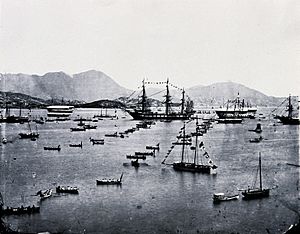
After the incident, people in Sydney decided to build a hospital. This was to show their gratitude for his recovery. It led to the building of Royal Prince Alfred Hospital.
Alfred quickly got better from his injury. He was able to return to his ship. He arrived back in England in June 1868.
He visited Hawaii in 1869 and met the royal family. He was also the first royal to visit New Zealand. In September 1869, he became the first European prince to visit Japan. He met the young Emperor Meiji in Tokyo.
The Duke's next journey was to India in December 1869. He also visited Ceylon (now Sri Lanka) and Hong Kong. He was the first British prince to visit these places. Indian rulers held grand parties for him. In Ceylon, a rich man named Charles Henry de Soysa hosted him. His home was renamed Alfred House.
Marriage and Family Life
In August 1868, Alfred met Grand Duchess Maria Alexandrovna of Russia. She was 14 years old. Alfred's sister, Princess Alice, was Maria's cousin.
On 23 January 1874, the Duke of Edinburgh married Maria Alexandrovna. She was the only surviving daughter of Emperor Alexander II of Russia. The wedding took place in Winter Palace, St Petersburg. A special biscuit, the Marie biscuit, was made to celebrate their marriage.
The Duke and Duchess of Edinburgh arrived in London on 12 March. Their marriage was not very happy. Maria was seen as proud by London society. She was surprised that she had to follow the Princess of Wales in rank. She wanted to be more important. Queen Victoria did not agree but gave her a high rank after the Princess of Wales. Maria's father gave her a large dowry of £100,000. He also gave her an annual allowance of £32,000.
Alfred was stationed in Malta for several years. His third child, Victoria Melita, was born there in 1876. He was promoted to rear-admiral in 1878. He then became admiral superintendent of naval reserves.
He was promoted to vice-admiral in 1882. He took command of the Channel Squadron. In 1886, he became Commander-in-Chief of the Mediterranean Fleet. He was promoted to admiral in 1887. In 1890, he became Commander-in-Chief, Plymouth. He reached the highest rank, Admiral of the Fleet, in 1893.
One naval officer, Percy Scott, said Alfred was an excellent leader. He handled a fleet very well. He also made many improvements in naval signals and movements. Alfred was also very interested in gunnery.
Alfred loved music very much. He helped to create the Royal College of Music in 1882. He played the violin, but he was not very good at it.
Duke of Saxe-Coburg and Gotha
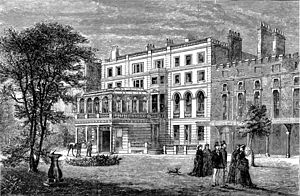
When his uncle, Ernest II, Duke of Saxe-Coburg and Gotha, died on 22 August 1893, Alfred became the Duke. His older brother had given up his right to this title. Alfred then gave up his British allowance of £15,000 a year. He also gave up his seats in the House of Lords and the Privy Council. However, he kept £10,000 to maintain Clarence House in London.
At first, people in the Duchy saw him as a "foreigner." But he slowly became popular. By the time he died in 1900, his subjects generally liked him.
Alfred and Maria's only son, Alfred, Hereditary Prince of Saxe-Coburg and Gotha, died on 6 February 1899. This was a very sad event for Alfred.
Alfred died on 30 July 1900 from throat cancer. He passed away at a lodge near Schloss Rosenau. This was the ducal summer home near Coburg. He was buried in the family mausoleum in Coburg. Since his younger brother and nephew had given up their rights to the throne, Alfred was followed by his nephew, Prince Charles Edward.
His mother, Queen Victoria, was still alive. She had already outlived two of her children. She died six months after Alfred.
Alfred was a big collector of glass and ceramic items. After he died, his wife gave his collection to the Veste Coburg. This is a large fortress above Coburg.
Legacy and Places Named After Him
Australia
Many places in Australia are named after Prince Alfred. These include:
- Royal Prince Alfred Hospital in Sydney.
- The Alfred Hospital in Melbourne.
- Prince Alfred College in Adelaide.
- Prince Alfred Park in Sydney.
- Prince Alfred Square in Parramatta.
- The Royal Prince Alfred Yacht Club in Newport.
The Alfred Hall in Ballarat was built for his visit in 1867. A suburb of the city was renamed Alfredton. Many streets, parks, and schools across Australia also bear his name. He laid the cornerstones for new town halls in Sydney and Melbourne. These buildings are still used today.
Barbados
Prince Alfred Street in Bridgetown, the capital of Barbados, is named in his honor.
Canada
Prince Alfred Bay in Nunavut was named after him. So was Cape Prince Alfred in the North West Territories. Two islands in Ontario are also named for him. The Prince Alfred Arch in Tangier, Nova Scotia, marks a spot he visited in 1861.
New Zealand
The small town of Alfredton in the lower North Island is named after him. Alfred Street in central Auckland also honors him. The settlement of Galatea is named after his ship. Mount Alfred in Wellington is named after him.
South Africa
Prince Alfred visited Port Elizabeth on his 16th birthday in 1860. There is a Prince Alfred's Terrace there. The Alfred Rowing Club, established in 1864, is the oldest sports club in South Africa. The South African Library was opened by Prince Alfred in 1860.
Port Alfred, on the Kowie River, was renamed after him. Prince Alfred Pass is a famous mountain pass in the Western Cape. It is known for its beautiful scenery.
In Simon's Town, the Prince Alfred Hotel was renamed after his visit in 1868. This town has been an important naval base for centuries. In Cape Town, Prince Alfred helped start the building of the Breakwater in 1868. This created a protective wall for the new Cape Town Harbour. This area is now the Victoria & Alfred Waterfront, a popular tourist spot.
Many streets in South Africa are named Prince Alfred Street. These include streets in Pietermaritzburg and Queenstown. Prince Alfred Hamlet, a small town, is also named after him.
United Kingdom
Prince Alfred was a stamp collector. He became the honorary president of The Philatelic Society, London in 1890. He may have inspired his nephew, George V, to collect stamps. Their collections combined to form the Royal Philatelic Collection.
Edinburgh of the Seven Seas, a settlement on Tristan da Cunha, was named after Alfred. He visited these remote islands in 1867.
The Manta alfredi is commonly known as Prince Alfred's manta ray.
Issue
| Image | Name | Birth | Death | Notes |
|---|---|---|---|---|
 |
Prince Alfred | 15 October 1874 | 6 February 1899 | Died before his father. |
 |
Princess Marie | 29 October 1875 | 18 July 1938 | Married King Ferdinand I of Romania. |
 |
Princess Victoria Melita | 25 November 1876 | 2 March 1936 | Married twice, had children. |
 |
Princess Alexandra | 1 September 1878 | 16 April 1942 | Married Ernst II, Prince of Hohenlohe-Langenburg. |
| Unnamed son | 13 October 1879 | 13 October 1879 | Born stillborn. | |
 |
Princess Beatrice | 20 April 1884 | 13 July 1966 | Married Infante Alfonso, Duke of Galliera. |
See Also
 In Spanish: Alfredo de Sajonia-Coburgo-Gotha para niños
In Spanish: Alfredo de Sajonia-Coburgo-Gotha para niños


